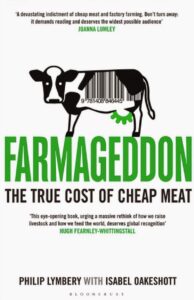 It’s so easy to feel a disconnect between the vacuum packed offerings in the meat aisle at your local supermarket and the origins of that product on the farm, but it is important that we know – and care about – where our meat comes from.
It’s so easy to feel a disconnect between the vacuum packed offerings in the meat aisle at your local supermarket and the origins of that product on the farm, but it is important that we know – and care about – where our meat comes from.
As the world’s population grows, the need to produce food faster has become more of a burden and now intensive farming practices seem to be creeping in globally, making the likes of battery hens and sow crates the norm instead of unpleasant methods that make us all more than a little uncomfortable.
Compassion in World Farming CEO Philip Lymbery is worried, and he believes we should be, too. With investigative journalist Isabel Oakeshott, he pulls back the covers on the global industry of farming and looks at what is wrong with it and why – and at what we can do to fix it.
Lymbery believes factory farming is bad news for farmed animals, human health, the environment, the world’s poorest people, and the world in general.
He and Oakeshott say that intensive farming does not – as the industry itself would have us believe – save space. In fact, because of the growing demand for land to grow animal feed for the poor creatures that are being subjected to the factory farming conditions, they reckon it does the opposite, with more than a third of the world’s arable harvests are being used to supply farmed animals.
Farmageddon takes the reader on a scary journey that includes dairy farms in California that milk 10,000 cows at once, massive piggeries in China, and an “organic” farm in Taiwan where 300,000 battery hens are living in appalling conditions.
I used to think “colony-laid” eggs were a kinder option until I was on a sightseeing trip last year and had the barns used by one New Zealand producer pointed out. I can’t remember the exact number of chooks that were being housed in it but remember being blown away by what I thought was a phenomenally large number. I checked the company’s website when I got home and saw the proud claim that they provide at least 750cm per hen. That’s not a lot of space at all, especially in an enclosed space with a gazillion other chooks.
There was a time when farms were family businesses, run by people who had generations of care invested in them, but now many are owned by corporations and care of the land and the animals isn’t necessarily a high priority: the sole focus is on profit. and as fast as possible.
In some parts of the world, farm animals have been disappearing from fields because allowing sheep and cattle to graze in paddocks isn’t the most efficient way to get market-ready meat quickly.
Because of this, we no longer know for sure just what is ending up in the food chain, as shown by the horse meat-scandal that his the United Kingdom earlier this year.
Some interesting points raised by the authors include:
- Half of all antibiotics used worldwide (rising to 80 per cent in US) are routinely given to industrially farmed animals, contributing to the emergence of deadly antibiotic-resistant superbugs
- Bees are now trucked across the States (and even airfreighted from Australia) to pollinate the fruit trees in the vast orchards of California, where a chemical assault has decimated the wild insect population
- Fish that could feed local populations are being turned into fishmeal for farmed fish, chickens and pigs thousands of miles away
We don’t know the long-term implications of all the antibiotics going into the meat we eat, or intensive farming’s impact on the spread of diseases such as bird flu and swine flu. However, we can already see the impact it is having on our environment.
Unfortunately, as much as we all like to think we’re doing the right thing by the planet, we also like to save a buck, so we still buy the cheap meat and produce that appears in our supermarkets.
This book is every bit as frightening as it is fascinating.
